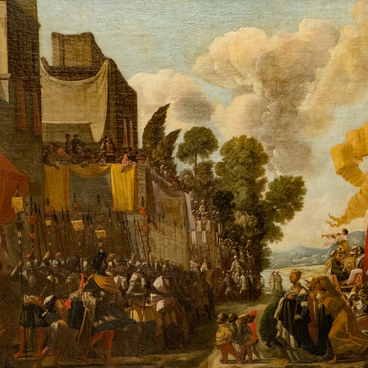The ceremonial portrait of Albrecht VII, Archduke of Austria, entered the museum as part of the collection of Professor Gabyshev as a male portrait of the Rubens workshop. This is a paired work for the portrait of Infanta Isabella Clara Eugenia.
The Archduke is depicted standing near a table covered with a bright red drapery embroidered with gold, emphasizing the status of the person portrayed. On the table is a black velvet hat with fluffy feathers. Around the neck is a carefully assembled round fluted ruff, trimmed with exquisite lace. The collar was held solely by a special metal frame. The Archduke’s left hand rests on the hilt of his sword; on the sleeves there is a thin gold pattern and lace ruffles that match with the collar. His doublet is adorned with gold buttons and a gold chain with a pendant in the form of a tiny fleece decorated with precious stones. The fleece pendant is the emblem of the Order of the Golden Fleece, the highest order of Spanish chivalry. It was presented to Albrecht in 1598 by King Philip II of Spain, who was his uncle. A year later, the Archduke married the king’s daughter, Isabella.
Albrecht was the youngest son of the Holy Roman Emperor Maximilian II. To build a career in the Roman Catholic Church, he was educated at the court of his uncle Philip. He was subsequently appointed Archbishop and Cardinal of Toledo in Spain. After the death of his brother Ernst, he took his place in 1595 and was appointed Stadtholder of the Netherlands. Albrecht was entrusted with the task of conquering the rebellious Protestants who stubbornly fought for independence in the northern provinces. In this regard, Albrecht had to renounce his holy orders. Albrecht had to ask the Pope for permission to do this, as well as to marry his cousin Isabella. The marriage turned out to be successful, and Albrecht and Isabella ruled the Netherlands until Albrecht’s death in 1621.
In 1609, Albrecht managed to secure a twelve-year
truce with the rebellious territories. During this period, the Spanish court in
Brussels was experiencing a cultural renaissance. Albrecht, like his wife, was
a patron of the arts, sponsored the artists of the golden age of Dutch
painting, and was interested in promoting art and science. There were poets and
musicians at the court in Brussels, and among the court artists were such
painters as Jan Brueghel, Otto van Veen and Peter Paul Rubens, who named his
firstborn after Albrecht.


